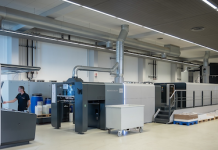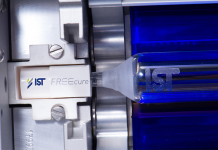The second version of ScreenPro screening engine introduces new PrintFlat technology to address the variations in ink density that can affect high-speed inkjet printing.
The new technology is intended to reduce non-uniformity in inkjet output caused by variation within a print head, between heads or wear on the head itself, which can create a curved ‘smile’ effect on the finished print.
ScreenPro 2.0 addresses each print head nozzle separately, resulting in finer granularity and an even tone. It can be added to new or existing inkjet presses as either a cross-platform development component, integrated into the workflow or as a branded user interface.
Product manager Tom Mooney said, ‘We have been working on the next stage of ScreenPro very much in depth, taking a step back to look at the further problems that screening software can address. It was the smile effect – in which the density of the ink varies as it is applied across the web – that kicked off this particular project and now we see significant futures in PrintFlat. This allows print service providers to produce an inkjet-made print that can be sold to clients. It may not be perfect, but as we continue to develop the technology perfect is certainly the aim. ScreenPro could be the difference between prints that are sellable and prints that are not.’
Non-uniform ink density distribution can create visible banding on inkjet output. The PrintFlat component of the ScreenPro 2.0 engine addresses this by automatically ‘tweaking’ the voltages of the heads – a process that can be time-consuming and damaging to the heads if done manually.
ScreenPro 2.0 can send screening data to the printer in real time at production speed and is designed to improve performance. It also addresses defects such as chaining and mottling. It can use screen applications designed by Global Graphics to address specific defects. including the recently-announced Mirror and Gloss.





















